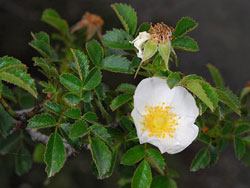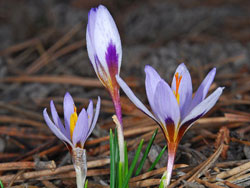|
Priceless Flora
 There is no denying that the flora of the Geopark is the richest in Cyprus and, for this reason, the Troodos mountain range is considered one of the most important mountain habitats for plants in the whole of Europe. This rich biodiversity is due to the great variety of habitats that are formed because of the differences of altitude, particular geology, the presence of water and the local terrain. There is no denying that the flora of the Geopark is the richest in Cyprus and, for this reason, the Troodos mountain range is considered one of the most important mountain habitats for plants in the whole of Europe. This rich biodiversity is due to the great variety of habitats that are formed because of the differences of altitude, particular geology, the presence of water and the local terrain.
The most representative examples of the influence of geology are the serpentinphilous endemics of Troodos, such as Onosma troodi, Acinos troodi, Cynoglossum troodi and Alyssum troodi as well as many plants that are only found in igneous rocks, such as Silene laevigata and Rosa chionistrae, and those that are found in the transitional zone of limestone and ophiolite rocks such as Silene gemmata and plants on outcrops of igneous rocks (chasmophytic vegetation) such as Sedum cyprium and Sedum microstachyum.
 Across the whole area of the Geopark, 92 different endemic plants of Cyprus have been recorded from a total of 143 on the island, i.e. about 64% in an area that represents only 12% of its territory. Of these, 37 are found exclusively in the Geopark and nowhere else in Cyprus or indeed in the world. It is also worth noting that 87 endangered species have been recorded out of 238 mentioned in the Red Data Book of the Flora of Cyprus. Equally important is the fact that the percentage of endangered species is low compared to the total number of species and this is the result of conservation measures and the relatively mild human intervention in the broader area. Across the whole area of the Geopark, 92 different endemic plants of Cyprus have been recorded from a total of 143 on the island, i.e. about 64% in an area that represents only 12% of its territory. Of these, 37 are found exclusively in the Geopark and nowhere else in Cyprus or indeed in the world. It is also worth noting that 87 endangered species have been recorded out of 238 mentioned in the Red Data Book of the Flora of Cyprus. Equally important is the fact that the percentage of endangered species is low compared to the total number of species and this is the result of conservation measures and the relatively mild human intervention in the broader area.
The enormous importance of the Geopark’s flora is indicated by another significant fact: it is home to 10 of the 19 plant species included in Annex 1 of the Habitats Directive. But over and above these impressive facts, thanks to its plant wealth, the Geopark is attracting more and more special interest tourists who visit Cyprus mainly to study and get more closely acquainted with its flora.
|